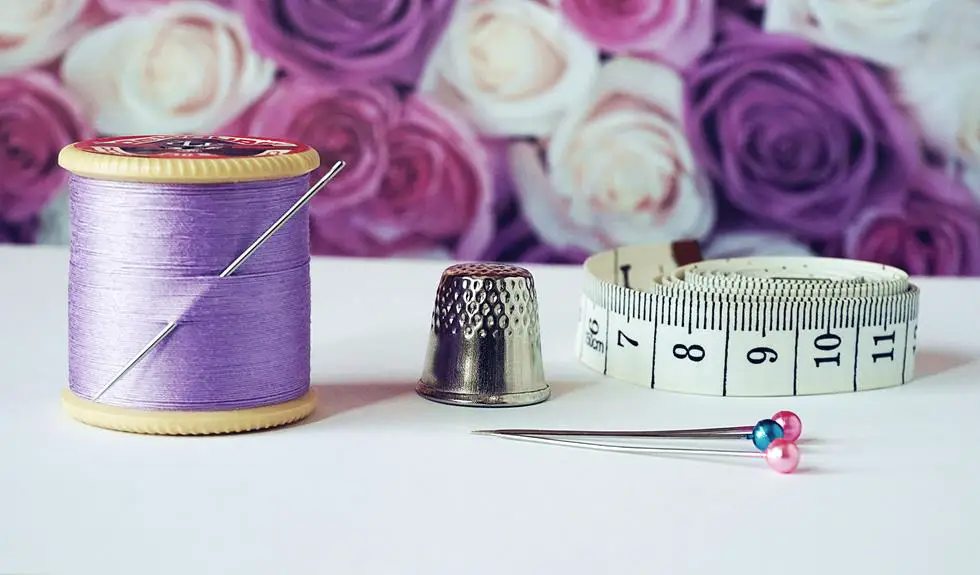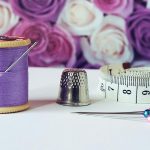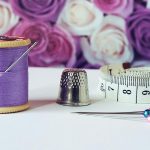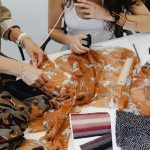When you're sewing, choosing the right pins for different fabrics can make a significant difference in your results. You might find that lightweight materials, like silk, require fine, sharp pins to prevent damage, while medium-weight fabrics need something more versatile. For heavy fabrics, sturdier pins are essential for maintaining stability. But it's not just about the fabric weight; factors like pin head type and even fabric sensitivity come into play. Understanding these nuances could transform your sewing experience, and you may be surprised by how much the right choice matters. What should you consider next?
Table of Contents
Key Takeaways
- Choose fine pins for lightweight fabrics to minimize damage, and opt for glass head pins for heat sensitivity.
- Use standard straight pins for medium weight fabrics, and ballpoint pins for knitted materials to prevent snagging.
- Select quilting pins for heavy fabrics to accommodate multiple layers, and use extra-long or heavy-duty pins for added strength.
- Maintain proper pin spacing of 3-4 inches for stability in medium and heavy fabrics, and closer for curves to avoid puckering.
Understanding Pin Types
When you're selecting pins for your fabric projects, it's crucial to understand the different types available and how they can affect your sewing experience. Each pin type serves a specific purpose, so knowing the right one can make all the difference.
First, consider standard straight pins. They're versatile and work well with most fabrics, but they may not be ideal for heavier materials. For thicker fabrics or multiple layers, opt for dressmaker pins. These pins have a larger head and a thicker shaft, making them easier to handle and more durable.
If you're working with delicate fabrics, such as silk or chiffon, choose fine pins. Their slender design reduces the risk of fabric damage, ensuring your pieces stay intact.
Quilting pins are another option, specifically designed for layered fabrics. They're longer and often have a larger head, allowing for easy removal while sewing.
Lastly, think about specialty pins, like curved or glass head pins. Curved pins are great for securing rounded edges, while glass head pins are heat-resistant, making them safe to iron over.
Factors Affecting Pin Choice
Several key factors influence your choice of pins, including fabric type, thickness, and the specific sewing techniques you're using.
First, consider the fabric type. Some fabrics, like silk or chiffon, require finer pins to avoid damaging delicate fibers, while heavier materials, such as denim, need sturdier pins that can penetrate thicker layers without bending.
Next, think about the thickness of the fabric. Thicker fabrics often call for longer pins to ensure they hold layers securely, while thinner fabrics benefit from shorter pins that won't leave large holes.
Additionally, the sewing technique you plan to use plays a crucial role. For example, if you're quilting, you might need pins designed specifically for that purpose, as they can handle multiple layers and help prevent shifting.
You should also consider the pin's head type; glass-head pins are great for heat-sensitive fabrics, while plastic heads might melt under high temperatures.
Ultimately, understanding these factors will help you select the right pins, ensuring smoother sewing and better results in your projects. Keep these considerations in mind for a successful sewing experience!
Lightweight Fabrics and Pins
Choosing the right pins for lightweight fabrics is essential to prevent damaging delicate materials while ensuring accurate stitching. When you're working with fabrics like chiffon, silk, or lightweight cotton, opt for fine, sharp pins. These pins will penetrate the fabric without causing snags or holes, preserving the integrity of your fabric.
You'll want to avoid using thicker, heavier pins, as they can leave larger holes and distort your fabric's drape. Instead, consider using fine glass head or silk pins. The glass heads allow for easy visibility and won't melt if you accidentally touch them with an iron.
Another great option is using a pin with a thin shaft. These pins glide through the fibers with minimal resistance, reducing the risk of damage. If you're pinning multiple layers, be cautious; too many pins can lead to misalignment when sewing.
Remember to space your pins closely for lightweight fabrics, as they tend to shift more easily. This helps maintain accuracy while sewing.
Medium Weight Fabrics
When working with medium weight fabrics, you'll want to choose the right pins to ensure a smooth sewing experience.
Understanding the different pin types, along with some handy fabric handling tips and pinning techniques, is essential for achieving the best results.
Let's explore these key points to help you pin effectively.
Pin Types Overview
For medium weight fabrics, you'll want to consider using pins that provide a secure hold without causing damage to the material. One great option is standard straight pins, which are versatile and come in various lengths and thicknesses. Choose pins that are long enough to penetrate through your fabric layers but not so long that they become cumbersome.
You might also find that ballpoint pins work well for knitted medium weight fabrics. Their rounded tip helps slide between fibers without snagging, ensuring a smooth sewing experience. If you're working with heavier materials like denim or canvas, consider using thicker, stronger pins specifically designed for those fabrics.
Another option is to use quilting pins, which are longer and have larger heads, making them easier to grasp and remove while you sew. They're especially useful when working with multiple layers.
Lastly, don't overlook specialty pins like fork pins or double pins, which can help you manage bulk or hold layers in place more effectively. By selecting the right type of pin for your medium weight fabric, you'll ensure a cleaner, more precise sewing project.
Fabric Handling Tips
Handling medium weight fabrics requires gentle manipulation to avoid stretching or distorting the material during your sewing process.
To begin, always lay your fabric flat on a clean, smooth surface before cutting or pinning. This helps maintain its shape and ensures accurate measurements.
When you're ready to cut, use sharp scissors or a rotary cutter to achieve clean edges. If you're working with a fabric that frays easily, consider using pinking shears or a serger to finish the edges right away.
While sewing, keep your stitches even and consistent. Avoid pulling the fabric as you guide it through the machine. Instead, let the feed dogs do their job. If your fabric is slippery, you might want to use a walking foot to help manage the layers without distortion.
Pinning Techniques Explained
Choosing the right pinning technique can significantly enhance your sewing experience with medium weight fabrics.
When working with these fabrics, you'll want to ensure your pins penetrate easily without damaging the fibers. Start by using a straight pin that's appropriate for the fabric type, such as a medium-sized pin for cotton or linen.
To pin your fabric, lay the pieces right sides together. Begin at one end and insert the first pin perpendicular to the fabric edge, about ¼ inch from the edge. This keeps the fabric layers aligned while you sew. Space your pins about 3-4 inches apart to maintain stability without hindering your sewing machine's foot.
For curved seams, use a slight zigzag pattern with your pins, placing them closer together to avoid puckering. Always remove your pins just before the needle gets there to prevent any needle damage.
If you're working with thicker seams or multiple layers, consider using ballpoint pins, which glide through the fabric more smoothly.
Heavy Fabrics and Pins
When you're working with heavy fabrics, choosing the right pins is crucial for success.
You'll want to explore different types of heavy pins and effective pinning techniques that provide the strength needed to hold everything in place.
Let's look at how these choices can make a significant difference in your sewing projects.
Types of Heavy Pins
Heavy fabrics require robust pins that can securely hold layers together without bending or breaking during the sewing process. When tackling materials like denim, canvas, or upholstery, you'll want to choose the right type of heavy pin to ensure a smooth sewing experience.
One excellent option is the quilting pin. These pins feature a thicker shaft and a sharp point, making them ideal for penetrating multiple layers of heavy fabric. They're designed to withstand the pressure of sewing without bending, which is crucial when working with dense materials.
Another great choice is the extra-long pin. These pins provide added length, allowing you to pin through thicker layers while keeping your fabric aligned. Their sturdiness helps prevent any shifting during sewing.
Lastly, consider using a heavy-duty pin. These pins are specifically designed for heavy fabrics and have a stronger construction than standard pins. They can handle the weight and bulk of thick textiles without compromising their integrity.
Pinning Techniques for Strength
Proper pinning techniques can make a significant difference in achieving strong, secure seams with heavy fabrics. When you're working with materials like denim or canvas, it's crucial to use the right pins and techniques.
Start by using long, sturdy pins specifically designed for heavy fabrics. These pins can penetrate thick layers without bending or breaking.
As you pin, always insert the pins perpendicular to the seam line. This way, you'll create a more stable hold and make it easier to remove them as you sew. Don't skimp on the number of pins; spacing them about 3 to 4 inches apart will help keep the fabric layers aligned.
For extra security, consider using a basting stitch before you start sewing, especially on curved seams. If your fabric shifts while you're working, it could lead to uneven seams. To minimize this, you can also use fabric weights instead of pins for larger pieces.
Specialty Fabrics Considerations
Choosing the right pins for specialty fabrics can make a significant difference in your sewing project's outcome.
When working with delicate materials like silk or chiffon, opt for fine, lightweight pins. These won't leave large holes and will help maintain the fabric's integrity.
For stretchy fabrics like knits, consider using ballpoint pins. They glide between the fibers without snagging, ensuring a smooth sew.
If you're sewing thicker or layered specialty fabrics, such as denim or leather, you'll need pins that can handle the bulk. Use longer, sturdier pins designed for heavy fabrics to ensure they penetrate easily.
Additionally, consider using clips instead of pins for fabrics that may shift, like vinyl or leather. Clips provide a stronger hold without damaging the material.
Tips for Effective Pinning
Effective pinning can significantly enhance your sewing experience, making it easier to achieve precise seams and a polished finish.
Start by choosing the right pins for your fabric type. For lightweight materials, opt for fine pins that won't leave large holes. For heavier fabrics, use thicker pins that can handle the bulk without bending.
When pinning, place your pins perpendicular to the seam line to ensure they're easy to remove while sewing. Space them about 4-6 inches apart for straight seams and closer for curves. This helps maintain the fabric alignment and prevents shifting. Always pin the fabric layers together with the right sides facing each other—this ensures your seam will look clean and professional.
Avoid over-pinning, as it can create unnecessary bulk, making it harder to sew accurately. Instead, focus on strategic placements. If you're working with slippery fabrics, consider using curved safety pins or clippable alternatives to keep everything in place without damaging the fabric.
Lastly, always remove the pins as you sew to prevent any accidental needle strikes. With these tips, your pinning technique will improve, leading to better sewing outcomes and a more enjoyable experience.
Frequently Asked Questions
What Is the Best Way to Store Sewing Pins?
The best way to store sewing pins is in a magnetic pin holder or a pin cushion. You'll keep them organized and easily accessible, preventing bending and losing pins while ensuring a safe workspace.
Can I Reuse Pins or Should I Replace Them Regularly?
You can definitely reuse pins, but keep an eye on their condition. If they're bent, rusted, or dull, it's best to replace them. Regularly checking ensures your sewing projects remain smooth and hassle-free.
How Do I Know When Pins Are Damaged or Dull?
You can tell pins are damaged or dull if they bend easily, won't penetrate fabric smoothly, or leave marks. Regularly inspect them for rust or chips, and replace any that show signs of wear.
Are There Eco-Friendly Pin Options Available?
Yes, there are eco-friendly pin options available! Look for pins made from sustainable materials like bamboo or recycled metals. These choices minimize environmental impact while providing the same functionality as traditional pins. You'll be sewing sustainably!
Can Pins Cause Fabric Damage Over Time?
Yes, pins can cause fabric damage over time, especially if used excessively or on delicate materials. You should regularly check for wear and choose appropriate pin types to minimize any potential damage to your fabrics.
- Tetron Fabric for Marine Applications: Durability and Use Cases - June 18, 2025
- Tetron Fabric for Outdoor Furniture: Weather Resistance and Care - June 18, 2025
- Tetron Fabric for Wall Coverings: Style and Application Tips - June 18, 2025







